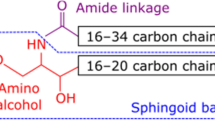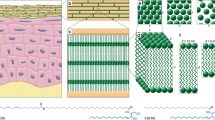Abstract
Alpha-hydroxy acids are effective agents for the treatment of skin xerosis and it is known that, following treatment with lotions containingd,l-lactic acid, the stratum corneum prevents xerosis more effectively. To date, the relative efficacy of the different isomers of lactic acid has not been evaluated and the mode of action of lactic acid in improving stratum corneum resilience is not known. The objective of the present studies was to determine the effects of lactic acid isomers on keratinocyte ceramide biosynthesis, stratum corneum barrier function and the resistance of the straum corneum to the appearance of skin xerosis. In vitro, lactic acid enhanced the production of ceramides by keratinocytes.l-Lactic acid was more effective than thed isomer (300% increase vs 100% increase). Carbon label from lactic acid was incorporated into all keratinocyte lipid species and a greater incorporation of label into ceramides was achieved withl-lactate than withd-lactate. In vivo, lactic acid increased the levels of stratum corneum ceramides. Whereas, lotions containingl-lactic acid resulted in the greatest increase (48% increase) followed byd,l-lactic acid (25% increase),d-lactic acid had no effect on stratum corneum ceramide levels. The increases in stratum corneum ceramide levels following lactic acid treatment also led to improvements in stratum corneum barrier function, measured by transepidermal water loss following a challenge to the skin with SLS and in the regression phase of a moisturization efficacy study. Significant improvements in barrier function and resistance to the appearance of skin xerosis were observed followingl-lactic acid andd,l-lactic acid, but not followingd-lactic acid treatment. From these results we believe that lactic acid, particularly thel isomer, stimulates ceramide biosynthesis leading to increased stratum corneum ceramide levels which results in superior lipid barrier and a more effective resistance against xerosis.
Similar content being viewed by others
References
Ayoub F, Zaman M, Thornally P, Masters J (1993) Glyoxalase activities in human tumor cell lines in vitro. Anticancer Res 13: 151–156
Bagatell F, Smoot W (1976) Obervations on lactate-containing emollient cream. Cutis 18:591
Bartolone J, Santhanam U, Penksa C, Lang B (1995) Hydroxy acids modulate skin cell biology. J Invest Dermatol 104:609
Bligh EG, Dyer WJ (1959) A rapid method of total lipid extraction and purification. Can J Biochem Physiol 37:911–917
Boisits EK, Nole GE, Cheney MC (1989) The refined regression method. J Cutan Aging Cosmet Dermatol I:155–163
Dahl MV, Dahl AC (1983) 12% lactate lotion for the treatment of xerosis. Arch Dermatol 119:27–30
Elias PM (1983) Epidermal lipids, barrier function and desquamation. J Invest Dermatol 80:44–49
Elias PM, Menon GK, Grayson S, Brown BE (1988) Membrane structural alterations in murine stratum corneum. Relationship to the localization of polar lipids and phospholipases. J Invest Dermatol 91:3–10
Friberg SE, Kayali I (1989) Water evaporation rates from a model of stratum corneum lipids. J Pharm Sci 78:639–643
Griffiths CEM, Voorhees JJ (1994) Human in vivo pharmacology of topical retinoids. Arch Dermatol Res 287:53–60
Hou SYE, White SH, Menon GK, Grayson S, Ghadially R, Elias PM (1991) Membrane structures in normal and essential fatty acid-deficient stratum corneum: characterization by ruthenium tetroxide staining and X-ray diffraction. J Invest Dermatol 96:215–223
Imokawa G, Akasaki S, Minematsu Y, Kawai M (1989) Importance of intercellular lipids in water retention properties of the stratum corneum: induction and recovery of surfactant induced dry scaly skin. J Invest Dermatol 281:45–51
Imokawa G, Abe A, Jin K, Higaki Y, Kawashima M, Hidano A (1991) Decreased levels of ceramides in stratum corneum of atopic dermatitis: an etiological factor in atopic dry skin? J Invest Dermatol 96:523–526
Kock WR, Berner B, Burns JL, Bissett DL (1988) Preparation and characterization of a reconstituted stratum corneum film as a model membrane for skin transport. Arch Dermatol Res 280:252–256
Lavker RM, Kaidbey K, Leyden JJ (1992) Effects of topical ammonium lactate on cutaneous atrophy from a potent topical corticosteroid. J Am Acad Dermatol 26:535–544
Lehninger HL (1975) The biosynthesis of lipids. In: Lehninger (ed) Biochemistry, Worth Publishers, New York, NY, pp 659–691
Marks R, Lawson A, Nicholl S (1983) Age related changes in stratum corneum structure and function. In: Marks R, Plewig G (eds) The stratum corneum. Springer, Berlin Heidelberg New York, pp 175–180
Middleton J (1983) Development of a cream designed to reduce dry flaky skin. J Soc Cosmet Chem 6:91–100
Reference deleted
Potts RO, Francoeur ML (1991) The influence of stratum corneum morphology on water permeability. J Invest Dermatol 96:495–499
Rawlings AV (1995) Skin waxes. Their composition, properties, structures and biological significance. In: Hamilton R, Christie (eds) Waxes The Oily Press, Dundee, UK, pp 223–258
Rawlings AV, Critchley P, Ackerman C, Parnell A, Rogers J, Oldroyd J (1992) The functional roles of ceramide one. Proceedings 17th IFSCC Yokohama, Japan I:14
Rawlings AV, Mayo AM, Rogers J, Scott IR (1993) Aging and the seasons influence stratum corneum lipid levels. J Invest Dermatol 101:483
Rawlings AV, Rogers J, Mayo AM (1993) Changes in lipids in the skin aging process. Biocosmet Skin Aging 1:31–45
Rawlings AV, Conti A, Rogers J, Verdejo P, Harding CR (1994) Seasonal influences on stratum corneum ceramide one linoleate content and the influence of topical essential fatty acids. Proceedings 18th IFSCC, Venice, Italy (IFSCC=International Federation of the Society of Cosmetic Chemists) 1: pp 127–137
Rawlings AV, Watkinson A, Rogers J, Mayo AM, Hope J, Scott IR (1994) Abnormalities in stratum corneum structure, lipid composition and desmosome degradation in soap-induced winter xerosis. J Soc Cosmet Chem 45:203–220
Rawlings AV, Harding CR, Scott IR, Bowser P (1994) Stratum corneum moisturization at the molecular level. J Invest Dermatol 103:731–740
Rawlings AV, Harding C, Watkinson A, Banks J, Ackerman C, Sabin R (1995) The effect of glycerol and humidity on desmosome degradation in stratum corneum. Arch Dermatol Res 287: 457–464
Rheinwald JG, Green H (1975) Serial cultivation of human epidermal keratinocytes: the formation of keratinizing colonies from a single cell. Cell 331–334
Stiller MJ, Bartolone J, Smith S, Nikoforos K, Gillian R, Drake LA (1995) Topical glycolic acid 8% andl-lactic acid 8% cream for the treatment of photodamaged skin: a double blind vehicle controlled clinical trial. J. Geriatic Derm (accepted)
Summers RS, Summers B, Chandar P, Feinberg C, Gursky R, Rawlings AV (1995) The effect of lipids with and without humectant on skin xerosis. J Soc Cosmet chem (accepted)
Van Scott E, Yu R (1974) Control of keratinization with 2-hydroxy acids and related compounds. Arch Dermatol 110:585–592
Vilaplana J, Coll J, Trullas C, Azon A, Pelejero C (1992) Clinical and non-invasive evaluation of 12% ammonium lactate emulsion for the treatment of dry skin in atopic and non-atopic subjects. Acta Derm Venereol (Stockh) 72:28–33
Wehr R, Krochmal L, Bagatell F, Ragsdale W (1986) A controlled two-center study of lactate 12 percent lotion and a petrolatum-based creme in patients with xerosis. Cutis 23:205–209
Wertz PW, Cho EI, Downing DT (1983) Effect of essential fatty acid deficiency on the epidermal sphingolipids of the rat. Biochim Biophys Acta 753:350–355
Wertz PW, Miethke MC, Long SA, Strauss JS, Downing DT (1985) The composition of ceramides from human stratum corneum and from comedones.J Invest Dermatol 84:410–412
Yamamoto A, Serizawa S, Ito M, Sato Y (1991) Stratum corneum lipid abnormalities in atopic dermatitis. Arch Dermatol Res 283:219–223
Yardley HJ (1987) Epidermal lipids. Int J Cosmet Sci 9:13–19
Author information
Authors and Affiliations
Rights and permissions
About this article
Cite this article
Rawlings, A.V., Davies, A., Carlomusto, M. et al. Effect of lactic acid isomers on keratinocyte ceramide synthesis, stratum corneum lipid levels and stratum corneum barrier function. Arch Dermatol Res 288, 383–390 (1996). https://doi.org/10.1007/BF02507107
Received:
Issue Date:
DOI: https://doi.org/10.1007/BF02507107




